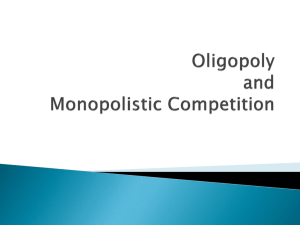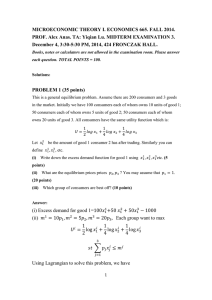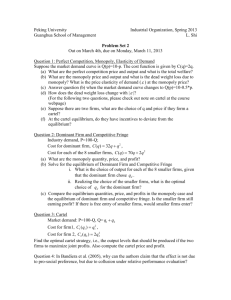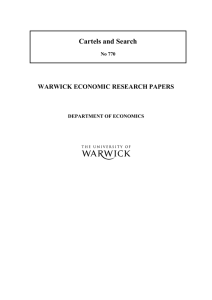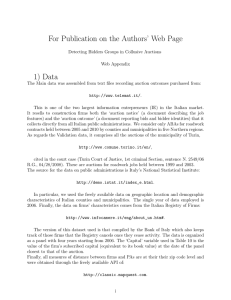20061114121198
advertisement
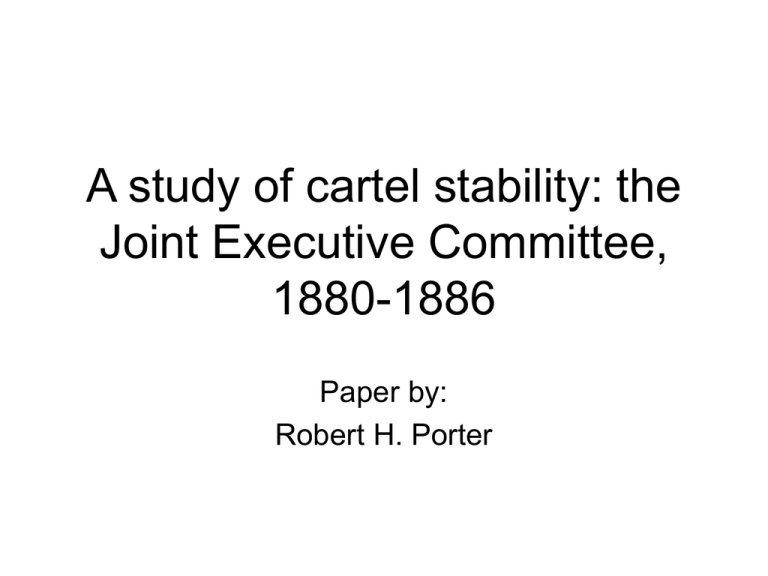
A study of cartel stability: the Joint Executive Committee, 1880-1886 Paper by: Robert H. Porter Objective • Use weekly time series data to test empirically that observed prices reflected switches from collusive to non-cooperative behavior in the JEC railroad cartel from 1880-1886 The Problem • Market does not face a consistent demand curve, so cartel firms don’t know if a change in price is the result of a firm cheating or the result of outside demand “shocks”. Model Assumptions • Firms set their own production level • Firms do not know the quantity produced by any other firms - they only observe the market price • Firms’ output is homogenous (they face a common market price) The Game • Repeating, multi-period game • Firms restrict output to increase overall profits • “Cheaters” are punished by an industry-wide switch to Cournot quantities for a fixed period of time, resulting in lower revenues for all firms. • Since firms do not observe one another’s output, this switch occurs once the market price falls below a previously decided “trigger price”. The Cheater’s (Dis)Incentive • In equilibrium, firms should produce at collusive output levels so that any price wars should occur after unexpected drops in demand - not after actual cheating. • Many such equilibria can be supported by an appropriately chosen “punishment pair” (trigger price, punishment period length). • To be effective, the “punishment pair” must offset the marginal gains of cheating with the implicit marginal losses of cheating. Setting the “Punishment Pair” • “Trigger Price” must be high enough to offset the incentive for firms to cheat by producing more output. NOTE: Desired effect can also be achieved by lengthening the punishment period. • “Trigger Price” must be low enough to where any and every outside shock will not lead to a reversion to Cournot pricing. NOTE: Punishment period could also be shortened to decrease the severity of these reversions. • Must be flexible. As industry output decreases towards perfectly collusive levels, the price (and therefore the incentive to cheat) will rise. So the “punishment pair” must be able to adjust in order to combat this trend. The Joint Executive Committee (JEC) • Cartel which controlled eastbound freight shipments from Chicago to the Atlantic seaboard in the 1880s • Because of the products shipped, shipping time was really not a factor. Therefore the assumption of homogeneity of goods seems to hold. • Cartel used market share allotments rather than absolute quantities shipped. • Firms set rates individually, and the JEC office took weekly accounts to see the total amount transported. The JEC (Continued. . .) • Demand was variable, so any change in market share could be from a change in a firm’s pricing (cheating) or outside forces. • Cartel passively accepted any new entrants and allocated them market shares, allowing the collusive agreement to continue • Principal competition came from lake steamer and sailships which were outside of the cartel agreement • Demand faced predictable fluctuations as a result of the annual opening and closing of the Great Lakes to shipping. The Econometric Model • Time series estimation where i denotes a particular firm and t denotes the time period (in weeks) • Date from 1880 -1886, so each year is segmented into 13 four-week segments to account for seasonal changes. • Model assumes output shares of JEC members are relatively stable across episodes of reversionary conduct The Variables The Equations • Demand relationship of the industry is given to be: log Qt = a0 + a1 log pt + a2Lt + U1t Where: pt = market price in period t Lt = dummy variable equal to 1 if Great Lakes are open and 0 otherwise • Supply relationship of the industry is given to be: log pt = Bo + B1 log Qt + B2St +B3It + U2t Where: Qt = total quantity demanded St = vector of dummies which reflect entry and acquisitions in the industry It = regime indicator which equals 1 for cooperative and 0 otherwise The Results Interpretations • Demand curves are very similar because they are not affected by the differences in PO or PN. • Supply curves show significant differences, with the coefficient attributed to the PN estimate being larger than PO with half the standard error. • Each of the variables has coefficients of the expected sign, which would indicate that the model is well defined. However, the “fits” are not particularly good. Interpretations (Continued . . .) • Setting all variables equal to their sample mean (using the PN estimate), we get the numbers in Table 4. • Price was 66% higher in cooperative periods and quantity 33% lower. • When lakes were open, price fell 4.5% and quantity fell 33%. • As a whole, the cartel could expect to earn 11% higher revenues during cooperative periods (about $11,000 per week in 1880 dollars). • The opening of the lakes caused revenues to fall about 35%. Plot of GR, PO, PN as a Function of Time • PO often reflects a price war before PN, but they normally switch back to unity together. This is consistent with GR not picking up secret price cuts, so there is a lag in the PN estimate. • On average, non-cooperative periods lasted about 10 weeks. • In this sample, price wars (using either PO or PN) were not preceded by adverse demand shocks. Normally incidents began after entry of another firm, though they were not immediate (average 40 week lag time). • This is consistent with theory, as the increase in number of participating firms leads to increased enforcement problems for the cartel. • Reversions also became more frequent as the number of firms increased. Comparison of Studies Comparison of Studies • PO series collected differs markedly from an index of cartel non-adherence created by MacAvoy. • We can see from Table 5 that during “breakdown” times, PN tends to resemble PO more than MacAvoy’s results. • Since PN was in no way constrained to resemble PO, it is evident that PN supports the documentation of the Railway Review and Chicago Tribune. Significance Test • Porter uses likelihood ratio tests to determine whether structural change has occurred in the industry, or if changes in price can be attributed to outside demand shocks. • Tests the null hypothesis that the coefficient on It is equal to zero (no regime change). Uses a chi-squared distribution with 1 degree of freedom. • Test-statistic = 554.1 - the null is overwhelmingly rejected! • Conclusion: Price and quantity changes cannot be attributed solely to exogenous changes in demand and structural conditions. Further Evidence of Collusion • In the “breakdown” years of 1881, 1884, and 1885 the JEC firms captured a much higher market share as a whole (see Table 6). • The PO and PN series are not systematically related to the opening or closing of the lake steamer shipping season. • Frequency of reversionary period increased as the number of market participants increased. • These facts refute the theory that price wars occurred only as a result of outside demand “shocks” and are consistent with a story of dynamic cartel enforcement mechanisms. Final Thoughts • Do you agree with the way in which the model was specified? • Are there any relevant variables that may have been omitted? Any irrelevant ones that you think were included?
